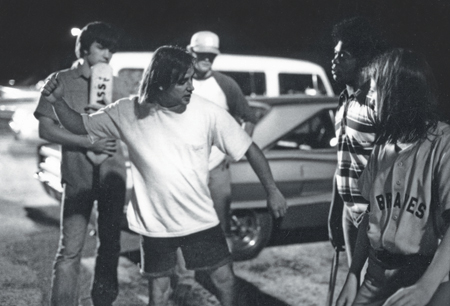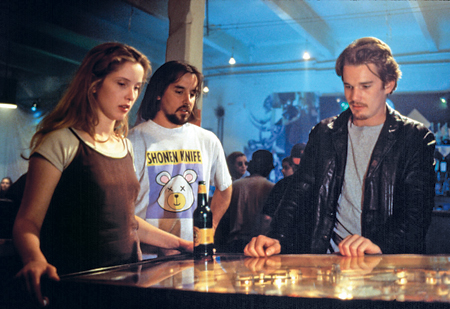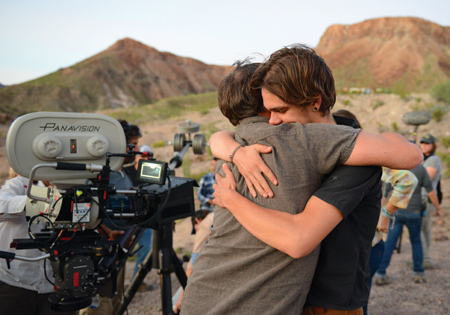Richard Linklater has always been fascinated by showing how lives change over a long period. In Boyhood, his latest and most ambitious film, he cast a young boy and watched him grow up—for 12 years.
BY AMY DAWES
In Boyhood, Linklater wanted to show the real-life changes of his actor Ellar Coltrane as he aged from six to 18. "It’s such a simple idea. But it hasn’t been done because it’s so impractical." (Photo: Courtesy Matt Lankes/IFC Films)
Director Richard Linklater seems wary of attaching any expectations to the outcome of Boyhood, the audacious feature he made over a 12-year span, even as it quietly amasses recognition on the festival circuit in the months leading up to its midsummer release. His "collaboration with time and the future," as he describes it, presents young Mason (Ellar Coltrane), whose development from age six to 18 is captured in yearly increments, and woven into a nearly three-hour story that expresses the wonder and universality of those changes, alongside the transformations in his divorced parents (Patricia Arquette and Ethan Hawke, Linklater’s frequent collaborator). Still, during an interview at his production headquarters in Austin, Texas, Linklater easily admits what the project means to him: "You know how when you’re really in love with something, you have strange thoughts?" he muses. "I told Ethan, ‘If I die, you have to finish this film.’ That means I’m really attached to it."
When Linklater began Boyhood, it was his ninth feature, and by the time it debuted at the Sundance Film Festival this year, it was his 17th. Making one film over such a long stretch raised all kinds of practical considerations, from the evolution in HD video (he chose to shoot on 35 mm film to avoid those fluctuations), to his own growth as a director. "It’s weird to say I don’t think I’ve evolved as a filmmaker in the last 12 years, but whenever I picked this up, I was intentionally not evolving," he laughs. "Since 2002 I’ve sort of calcified."
Linklater has often used time as a formalist element in his work. Dazed and Confused (1993) takes place in 24 hours beginning on the last day of high school, while Before Sunset (2004) unspools in 80 minutes of real time. With Boyhood, he was able to explore more fully what he considers his grand thematic obsession.
"Time and cinema is a powerful combination," he muses. "I’ve spent my whole adult life thinking about it, and admiring filmmakers who’ve dealt with it poetically." His achievement in Boyhood has been compared to that of François Truffaut, who followed his Antoine Doinel character (Jean-Pierre Léaud) through five films over 20 years, beginning with The 400 Blows, as well as Michael Apted, whose Up documentary series started with a group of British schoolchildren and revisited them at seven-year intervals up through age 56. Linklater sees it differently: [Showing] "those gaps in time was not really what I was going for here. I wanted it to be perceived the way we process our own lives unfolding. You just notice that someone is taller now, or their hair is different, or they’ve moved, or remarried. Film is a powerful record of time passing, and it forces you to see things with perspective."
This isn’t the first time Linklater has disrupted notions of what a film can be, how it can be made, or by whom. In his plot-free first feature with an actual crew and a budget, Slacker (1990), for example, the camera appears to hustle through the streets of Austin alongside wingnut residents of the college town as they spew their schemes and conspiracy theories. In reality, they are nonprofessional actors, performing a script Linklater wrote and choreographed.

LOCAL COLOR: Filmed in Austin, Dazed and Confused was Linklater’s first studio experience. It takes place in 24 hours on the last day of high school. (Photo: Universal Pictures/AMPAS)
In the first part of his romantic art film trilogy, Before Sunrise (1995), talky young lovers (Hawke and Julie Delpy) meet on a train in Europe. Linklater and his cast decided to revisit the same couple twice more, at nine-year intervals, in Before Sunset (2004) and Before Midnight (2013). Two of his features, Waking Life (2001) and A Scanner Darkly (2006), are comprised of live action footage traced over with rotoscope animation for an effect apropos to their surreal or drug-addled content, which is philosophically engaging in a way that American films rarely are.
The independent feature Bernie (2011), starring Jack Black and Shirley MacLaine, is the true story of a beloved small town figure convicted of murder, and is narrated, documentary-style, via interviews with East Texas townspeople (mostly nonprofessionals recruited in an open call). Linklater says it took him years to figure out how to approach the material. "That’s what you do as a director. For me, the big moment is how you’re going to tell a story. How do you want it perceived? By the time I learned about Bernie, he was already in jail, so everything I heard was from secondary sources, like a gossip circle. He was defined by other people’s perceptions. I realized that was a fun way to get information."
Linklater has also made four studio films—Dazed and Confused, The Newton Boys (1998), School of Rock (2003), and Bad News Bears (2005)—while managing never to move to Hollywood. Now in his 50s, he remains so casual in his demeanor, so unassuming about his achievements, that it would be easy to assign him the same go-with-the-flow qualities as some of his movie characters. But that would be way off the mark. "By the time I was being treated like an overnight success with Slacker, I had been making films on my own for eight years," he says. "I’d spent a decade devoting 18 to 20 hours a day to cinema, watching 600 films a year, reading and thinking about it every waking second."
He came of age during the 1970s in Huntsville, an East Texas town best known for its state prison, located in the same Piney Woods rural area
as Longview, the hometown of Matthew McConaughey who has appeared in three Linklater films. "We had one theater in town that played fourth-tier films; you’d go to the drive-in, and see Elvis movies and science fiction," he says. "The idea of making a movie was very far from my consciousness. My background was literature, philosophy, and theater."
But he also excelled in sports, attending Sam Houston State University on a baseball scholarship. In the late ’70s and early ’80s, Linklater became captivated by independent films such as The Return of the Secaucus Seven and My Dinner With Andre. But seeing Martin Scorsese’s Raging Bull was the real revelation. "I thought, ‘Film can do this?’" The idea that cinema could be his destiny came as "a slow realization. I had a visual memory—I was always seeing shots in my head, and I liked working with a lot of people. But it was about getting the courage."
And the money.
He dropped out of college and spent two-and-a-half years working on an offshore oil rig. "I saved up 18 grand and moved to Austin where my rent was $150 a month." The rest of the money went to a Super 8 camera, film stock and processing. Rather than enroll in film school at the University of Texas, he self-educated, while availing himself of the school’s resources and talent. "There were numerous years where all I did was watch films and work on movies. It was great."
Too shy at first to involve others in his work, Linklater made one solo, experimental short film after another, culminating in a Super 8 feature, It’s Impossible to Learn to Plow by Reading Books (1988), a formalist exercise comprised mostly of master shots with himself in the lead, which director Monte Hellman has described as "extremely realistic and painfully poetic."

ROMANTIC TRILOGY: Before Sunrise, with Julie Delpy and Ethan Hawke, was the first of a three-film, two-decade love story. (Photo: Sony Pictures Entertainment/Everett)
By the time Slacker debuted at Sundance in 1991, there was already an indie film farm system of sorts in place. When Universal Pictures movie exec Jim Jacks heard that Linklater was writing a teenage rock ’n’ roll movie, he called and expressed interest. The finished script, which became Dazed and Confused, was strong enough to leapfrog other projects and go into production with a $6 million budget. It was a full-on studio experience, and became Linklater’s trial by fire.
"There were cards, comments, executives watching dailies," says Linklater, who filmed in Austin with a cast that included McConaughey, Parker Posey and Ben Affleck—all then-unknowns. "There was a lot of pressure—this air of, ‘are you really a filmmaker? Or did you just get lucky?’
"It was a real test whether or not I could go through that system and still achieve the film I set out to make. There were a million roadblocks. Ultimately, I decided, I’m gonna do what I have to do to outlast them. It meant everything to me, and I didn’t care if I never made another film again. I would’ve taken the negative with me and burned it. I just had that attitude, and they could sense it."
The film, a music-laden comedy brimming with subversive spirit and an infectious party ethos, is revered by many as a teenage cult classic. But it didn’t test well. "Nothing big happens in it, and I think that handicapped it commercially," says Linklater. "Universal kind of cut bait on the marketing effort. It made about eight or nine million, but it didn’t make 50. My life would have been a lot easier if it had."
His passionate advocacy for the version he believed in made it all the harder to accept a muted outcome. "I made the mistake of wanting a result, wanting it to do well," he confesses. There, then, lie the seeds of his tamped down expectations for Boyhood.
While the film can scarcely be expected to play to the mainstream, more than one critic has already called it his masterpiece. "It’s such a simple idea," says Linklater of his desire to let film record a boy growing up. "But it hasn’t been done because it’s so impractical. It requires a real leap of faith to imagine that everyone will still want to be involved 12 years in the future." The longest legal contract to which he could sign his young star was seven years. After that, and for most of the participants, "it was all good faith. We liked that better anyway," he says. "My deal was to make it a fun project to work on that was fulfilling artistically to the people who did it."
Some 400 crewmembers came and went during the course of shooting. Surprisingly, his financier, IFC Films, and its president, Jonathan Sehring, never wavered. IFC came aboard having backed two of Linklater’s low-budget films, Waking Life and Tape (2001), a play adaptation made for $100,000. Both features returned their investment. But Boyhood was such a personal project for Linklater that he managed to work out a deal in which he maintained part ownership in the film. "Financing it," he says, "was still a weird concept for business people: ‘We’re going to start spending money, and we won’t see it for 13 or 14 years?’"

FEELING IT: For Linklater and Coltrane, Boyhood was a labor of love. (Photo: Courtesy Matt Lankes/IFC Films)
The amount of preproduction the project required came as a bit of a surprise. "We only shot three or four days a year, but every time, it would take a week of prep," he says. Once he had new footage, Linklater and Sandra Adair, his longtime editor, would add it to the growing reel. "Every year it got about 15 minutes longer. I knew where it was going structurally and architecturally, but the unique thing was that, in terms of its essence, we could say, ‘OK, what’s working here?’ and make changes going forward, because we had that long gestation time."
In other ways, his process was consistent with his other films, in which he emphasizes rehearsal and the full creative involvement of his actors. "I always try to get a lot of rehearsal time, because the magic moment when things come alive is when the ideas in the text meet the real person being manifested through this character," he explains. "I trained as an actor early on, and I try to be the director I wanted as an actor—one who’d listen to me, tap into who I was, and incorporate ideas."
That’s one reason he likes to work with Hawke. "He’s not afraid to say, ‘I’ve seen that before; it’s a cliché,’" says Linklater. "He was after me six months before we shot the last scene, where he’s at the graduation party with Ellar, saying, ‘What’s going on there? Why’d you make this film?’ I like that. Ethan and Patricia and I are all parents, and we all had parents. There’s a lot to draw on."
The performances in Linklater’s films are remarkable for their naturalism, but that effect, he emphasizes, requires well-honed writing and rehearsal. "There has to be substance and rhythm there. It can’t be repetitive. For all the looseness my movies appear to have, I really do work things out. There’s a clean throughline, along whatever terms I’ve set up. I never have to do re-shoots." In Boyhood, given the challenges of the one-year shooting gaps, "I paid a lot of attention to the transitions, but I always do. As a director, that’s always a big focus—how to create that storytelling flow, image to image."
Postproduction took place at Austin Studios, where Linklater’s office and editing bay are in a turquoise-colored triple-wide trailer that he bought and moved there. The 20-acre facility occupies the site of a former city airport; the hangars have become soundstages.
Linklater’s decision to plant his flag in Austin and remain there has been both a help and a hindrance, he thinks, in maintaining a career that he sees more in terms of his struggles than achievements. "I have a stack of things I’ve written and developed that I’m still trying to get financed," he says. "There’s not a lot of strategy; it mostly comes down to, what feels right to me internally, and what can get made at any particular time." The low overhead afforded by Austin, and the low budgets he has never hesitated to work with, have been essential in allowing him to experiment with projects like Boyhood. "I think I’ve probably paid the outsider’s price. But on the other hand, I haven’t been tempted as much to do things I have trouble getting excited about."